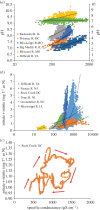Novel 'chemical cocktails' in inland waters are a consequence of the freshwater salinization syndrome
- PMID: 30509916
- PMCID: PMC6283973
- DOI: 10.1098/rstb.2018.0017
Novel 'chemical cocktails' in inland waters are a consequence of the freshwater salinization syndrome
Abstract
Widespread changes in water temperatures, salinity, alkalinity and pH have been documented in inland waters in North America, which influence ion exchange, weathering rates, chemical solubility and contaminant toxicity. Increasing major ion concentrations from pollution, human-accelerated weathering and saltwater intrusion contribute to multiple ecological stressors such as changing ionic strength and pH and mobilization of chemical mixtures resulting in the freshwater salinization syndrome (FSS). Here, we explore novel combinations of elements, which are transported together as chemical mixtures containing salts, nutrients and metals as a consequence of FSS. First, we show that base cation concentrations have increased in regions primarily in North America and Europe over 100 years. Second, we show interactions between specific conductance, pH, nitrate and metals using data from greater than 20 streams located in different regions of the USA. Finally, salinization experiments and routine monitoring demonstrate mobilization of chemical mixtures of cations, metals and nutrients in 10 streams draining the Washington, DC-Baltimore, MD metropolitan regions. Freshwater salinization mobilizes diverse chemical mixtures influencing drinking water quality, infrastructure corrosion, freshwater CO2 concentrations and biodiversity. Most regulations currently target individual contaminants, but FSS requires managing mobilization of multiple chemical mixtures and interacting ecological stressors as consequences of freshwater salinization.This article is part of the theme issue 'Salt in freshwaters: causes, ecological consequences and future prospects'.
Keywords: inland waters; non-point source water pollution; salinization; water quality.
© 2018 The Author(s).
Conflict of interest statement
We declare we have no competing interests.
Figures




Similar articles
-
Sensors track mobilization of 'chemical cocktails' in streams impacted by road salts in the Chesapeake Bay watershed.Environ Res Lett. 2021 Mar 1;16(3):035017-35017. doi: 10.1088/1748-9326/abe48f. Environ Res Lett. 2021. PMID: 34017359 Free PMC article.
-
Freshwater Salinization Syndrome Alters Retention and Release of 'Chemical Cocktails' along Flowpaths: from Stormwater Management to Urban Streams.Freshw Sci. 2022 Sep 1;41(3):420-441. doi: 10.1086/721469. Freshw Sci. 2022. PMID: 36213200 Free PMC article.
-
Making 'Chemical Cocktails' - Evolution of Urban Geochemical Processes across the Periodic Table of Elements.Appl Geochem. 2020 Aug 1;119:1-104632. doi: 10.1016/j.apgeochem.2020.104632. Appl Geochem. 2020. PMID: 33746355 Free PMC article.
-
Lost in translation: the German literature on freshwater salinization.Philos Trans R Soc Lond B Biol Sci. 2018 Dec 3;374(1764):20180007. doi: 10.1098/rstb.2018.0007. Philos Trans R Soc Lond B Biol Sci. 2018. PMID: 30509909 Free PMC article. Review.
-
Regulations are needed to protect freshwater ecosystems from salinization.Philos Trans R Soc Lond B Biol Sci. 2018 Dec 3;374(1764):20180019. doi: 10.1098/rstb.2018.0019. Philos Trans R Soc Lond B Biol Sci. 2018. PMID: 30509918 Free PMC article. Review.
Cited by
-
Drivers of spatio-temporal patterns of salinity in Spanish rivers: a nationwide assessment.Philos Trans R Soc Lond B Biol Sci. 2018 Dec 3;374(1764):20180022. doi: 10.1098/rstb.2018.0022. Philos Trans R Soc Lond B Biol Sci. 2018. PMID: 30509921 Free PMC article.
-
Sensors track mobilization of 'chemical cocktails' in streams impacted by road salts in the Chesapeake Bay watershed.Environ Res Lett. 2021 Mar 1;16(3):035017-35017. doi: 10.1088/1748-9326/abe48f. Environ Res Lett. 2021. PMID: 34017359 Free PMC article.
-
Freshwater Salinization Syndrome Alters Nitrogen Transport in Urban Watersheds.Water (Basel). 2023 Nov 9;15(22):1-22. doi: 10.3390/w15223956. Water (Basel). 2023. PMID: 38313692 Free PMC article.
-
Freshwater Salinization Syndrome Alters Retention and Release of 'Chemical Cocktails' along Flowpaths: from Stormwater Management to Urban Streams.Freshw Sci. 2022 Sep 1;41(3):420-441. doi: 10.1086/721469. Freshw Sci. 2022. PMID: 36213200 Free PMC article.
-
An overlooked route of inhalation exposure to tap water constituents for children and adults: Aerosolized aqueous minerals from ultrasonic humidifiers.Water Res X. 2020 Jul 28;9:100060. doi: 10.1016/j.wroa.2020.100060. eCollection 2020 Dec 1. Water Res X. 2020. PMID: 32793876 Free PMC article.
References
-
- Kaushal SS, Likens GE, Jaworski N, Pace ML, Sides AM, Seekell D, Belt KT, Secor DH, Wingate RL. 2010. Rising stream and river temperatures in the United States. Front. Ecol. Environ. 8, 461–466. (10.1890/090037) - DOI
Publication types
MeSH terms
Substances
Associated data
LinkOut - more resources
Full Text Sources

